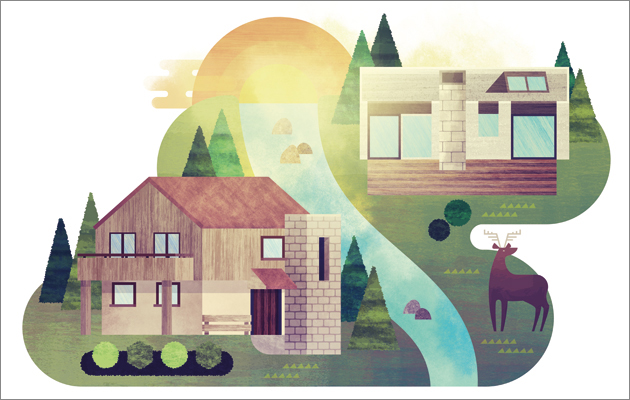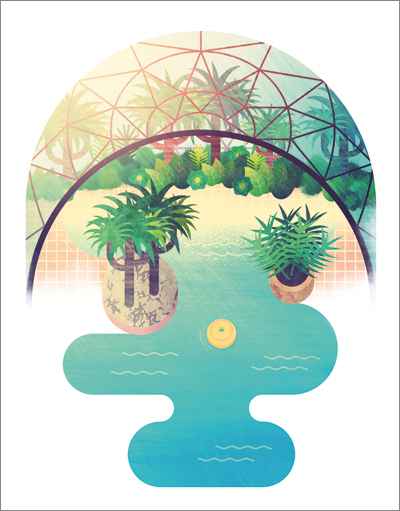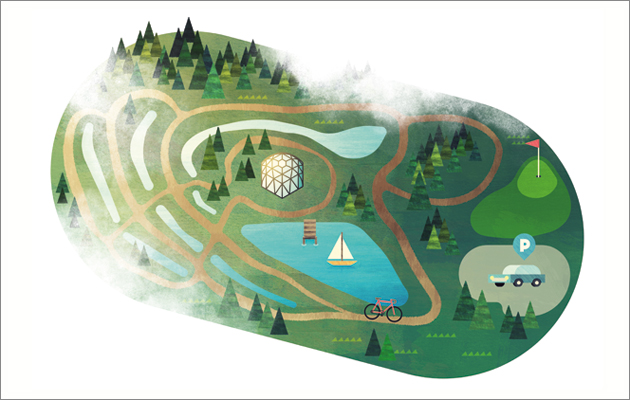|
|
||
|
Center Parcs has become a commercial phenomenon since the first camp opened nearly 50 years ago. But it still owes much to the original vision of the “villa in the forest” – an unlikely fusion of Dutch modernist ideals and Catholic moral conservatism, says Tim O’Callaghan My interest in Center Parcs sprang from vague recollections of childhood holidays spent in elegant modern villas set in a forest. Something about these memories suggested an intriguing story, and subsequent research uncovered a surprisingly rich architectural and social history that reveals a great deal about our evolving holiday habits, and possibly even about our future (sub)urban communities. Center Parcs continues to be extremely successful, drawing new generations of families with its promise of an escape into nature that retains all modern conveniences and distractions. It provides a short break where you set your own timetable and spend time with family in relaxing and contemplative forest surroundings. Yet its origins are more interesting and complex than might be expected, encompassing ideas from Dutch structuralism, economic neoliberalism and Catholic moral conservatism. Center Parcs originated in Rotterdam in 1953 with its founder Piet Derksen. Derksen was a mid-level office clerk with Dutch consumer-goods giant Unilever but, at the age of 40, he unexpectedly quit his job and became an entrepreneur: setting up a new discount sports shop – Sporthuis Centrum – in Rotterdam’s newly constructed Ljinbaan, Europe’s first pedestrianised shopping street. The store was a great success and the chain quickly expanded across the Netherlands. Its growth was such that in 1963 Derksen created a holiday retreat for his workers and customers near Reuver, close to the German border, in what passes for countryside in Holland. Initially, the camp was only a series of tents in a field, in the tradition of the European workers-union camp or American corporate retreat (the latter incidentally also the inspiration for Butlins). However, Derksen seems to have grasped its commercial potential very quickly – in 1968 he commissioned leading architectural practice Van den Broek & Bakema to help realise his vision of “the villa in the forest”. It was an astonishing marriage in many ways. Unlike his equivalents in other countries – Billy Butlin in the UK, Walt Disney in the US – who created cults of personality to help define their enterprises, Derksen was a very private man. Though little was written either by him or about him, two things are clear. The first is that he was a devout and morally conservative Catholic – Derksen was a regular churchgoer throughout his life and, following the sale of Center Parcs in 1989, he ploughed much of his personal fortune into Catholic journals and radio stations that fought what he perceived to be moderate and liberal forces in the Church’s hierarchy. The second is that he was a brilliant and intuitive entrepreneur, pioneering what appears to have been an early version of Sports Direct before revolutionising the short-break holiday market in northern Europe. By contrast, much has been written both by and about Jaap Bakema. He was the most influential Dutch architect of his generation and one of the core members of Team X – the CIAM splinter group that positioned itself as representing a more humane and contextual version of modernism, and included major figures such as Aldo van Eyck and Alison and Peter Smithson. Viewed by other members as the senior figure and driving force of the group, Bakema’s death in 1981 precipitated the formal end of Team X’s collaborations. Bakema was definitely an idealist and very probably a socialist but, as the son of a builder, he was also an architect who was prepared to get his hands dirty in the real business of building, occasionally to the dismay of his colleagues. Peter Smithson described him as “a good working architect when he was young … [but] in the end the buildings suffered because the office did them, because you can’t put your energy everywhere”. He was certainly prolific, especially in Rotterdam, where he masterplanned much of the city’s rebuilding following its razing during the Second World War – including the Lijnbaan, home of the first Sporthuis Centrum. This hands-on approach was in marked contrast to those of his more theoretically minded Team X colleagues – Bakema understood the need to compromise and to work with clients who might not share his world view.
Despite this, he retained grandiose visions of the architect-as-hero, proclaiming that “the architect has to stand between the client’s ego and society”. Bakema wrote much about his own humane, ecologically aware vision of modern architecture – a counterpoint to the rationalism and destructiveness that accompanied much of modernism. This incipient environmentalism included an uncannily prescient prediction of our evolving relationship with nature. In 1942 he stated: “The relationship man + man is too narrow; it must be man + nature + idea about nature.” It was the collaboration between these two contrasting figures that created the fundamental principles of Center Parcs – these, to a greater or lesser extent, still remain in place today, fusing Derksen’s puritanism and intuitive entrepreneurialism with Bakema’s socially driven version of modernism. Bakema’s first design for Sporthuis Centrum (as it was still called) in Reuver included 30 villas clustered around a “Center” that combined a swimming pool and some basic outdoor sports facilities, establishing a layout that endures today. The original villa design was repeated in all new villages right up to the early 1990s, including the early UK sites. These villas were simple, single-storey bungalows with low, flat roofs, sunk into the ground to minimise visual impact. They were constructed from bespoke exposed concrete blocks, cast at a deliberately small, domestic scale. Large, unpainted wooden windows framed the Each villa was based on a simple square module in plan, which could be added to or subtracted from easily, varying the size and capacity of the accommodation. The units were set out in a staggered terrace arrangement (a favourite device of Bakema), which meant that the flank of one helped define the external terrace of the next. This also preserved privacy, blocking views from one villa to the next and preventing terraces from overlooking each other. The design was a tremendous success; the villas were cheap and easy to build, and they were popular with guests: cosy, simple and perfectly scaled for a weekend away. On a larger scale, Bakema’s plan for the “villages” was equally clever. Villas were laid out concentrically from the Center, and each row of terraces was separated by an artificial lake, again preserving a sense of privacy and of being in nature. These lakes actually covered the temporary access roads made during the construction of the village, submerging the tracks and scars of diggers and lorries while creating the artifice that they had always been there. Center Parcs acted, in many ways, as a test bed for Bakema’s thoughts on nature and dwelling: The idea is to cluster houses in such a way that by the human eye you can register interrelationship between various social 1. Under the trees In the first category, you live directly with the soil. Indeed, the architect often referred back to his work on Center Parcs as informing his later theories, saying that “we realised the importance of planning community facilities that can easily be reached on foot, especially when living space is restricted … Perhaps the most important result of our work was the knowledge that the organisation of space is made possible by the interaction between water, parks and the forms of the buildings.” Bakema’s vision of “the neighbourhood group-idea” of modest dwellings as the “basis for planning new built environments in industrialised society” set him in contrast with not only the modernists of the early 20th century but also with some of his Team X colleagues – notably Shadrach Woods and George Candilis, who were at the same time creating vast Alpine snowships and beach resorts for the French state as part of its policy to bring summer and winter holidays to all of its citizens. These state-sponsored monolithic interventions in monumental landscapes were in sharp contrast to Bakema’s villas, which belonged to an Anglo-Dutch tradition of smaller (and generally privately funded) building projects set in more bucolic and benign locations. The genius of Center Parcs lies in the combination of Bakema’s ideas concerning architectural scale, relationships to nature and the balance of privacy and community with Derksen’s own intuitive understanding of what modern families wanted – privacy, convenience and freedom. Center Parcs’ fundamental ethos of “wholesomeness” stemmed from idealised notions of the family, outdoor pursuits and nature, and surely connects back to Derksen’s spiritual and moral views. He ensured the presence of a chapel in each village (English locations have only recently removed or converted these buildings). In addition, a series of large crosses made from painted steel beams were scattered across every site. Bakema provided architectural finesse and brought sophisticated, even prophetic ideas about our relationship with nature. Derksen placed these in the context of a business model that was similarly prescient in predicting the holiday habits of an emerging and expanding neoliberal middle class, and proved very good at exploiting their spending habits. The Center Parcs “formula” was completed in 1980, a year before Bakema’s death, with the construction of the first “sub-tropical swimming paradise” at de Eemhof – a dome that could hold a swimming pool complete with slides, rapids, wave machines and jacuzzis. This was a significant moment for the Center Parcs brand, cementing its ability to compete as a year-round destination, while also providing its first real architectural icon. It was the moment that Center Parcs morphed from “the villa in the forest” to “the machine in the garden” – the moment it embraced technology into nature. By the time Center Parcs appropriated the dome, the form had already undergone an ideological tug-of war between technocrats such as Buckminster Fuller and hippies living in and writing about domes in America’s western deserts. Center Parcs brought what had until that point remained an alternative architectural form into the mainstream, beating Walt Disney’s famous “Spaceship Earth” sphere at his Epcot theme park in Florida by two years. The dome’s association with nature and natural form fitted neatly into Center Parcs’ self-image, while its ability to enclose an artificial environment greatly enhanced the leisure facilities, providing a tropical playground, a centre of pleasure and a futuristic vision. |
Words Tim O’Callaghan
Illustrations Sam Glynn |
|
|
||
|
|
||
|
Once Center Parcs arrived in the UK in 1987, it was a fully formed and highly refined commercial product. Its success was almost immediate, the business quickly gaining a reputation as a middle-class version of Britain’s own holiday camp institution, Butlins. This comparison is a simplification, but it does point to the changes in our holidaying habits and broader social and political trends during that period. Butlins resorts were urban: created close to existing towns and resorts, they adopted the density and characteristics of the city, with straight rows of chalets, their gable ends facing forwards, like working-class terraces along paved roads. This urban, communal experience is in contrast to the more rural and individual vision of Center Parcs, which are located in “virgin forest” and rely on visitors’ private transport. Center Parcs is highly personal, with each family setting their own agenda; the closest it gets to communality is the occasional badminton tournament or teenage roller disco. In a sense, it is the antithesis of a Disney or Butlins holiday. Where Center Parcs projects the appearance of authenticity, of naturalness, Disney and Butlins both revel in the artificial, creating new worlds and experiences in papier-mâché and painted concrete. Yet in truth, Center Parcs’ version of nature is a highly manipulated one, closer to a garden or a park than true wilderness. Beneath your feet are electrical wires and a complex system of water and gas pipes. The villages are constructed in existing forests, but the environment is rapidly augmented: more trees are planted, the wildlife is artificially housed and fed, and rare bird and animal species are introduced. Real wilderness is inconvenient, hard, unpredictable and sometimes frightening. It may even be humbling. In contrast, Center Parcs’ benign vision of nature – a condensation of various natural ecologies, tamed, packaged and commodified to enhance the appearance of “naturalness” for a mass audience – is symbolic of man’s supremacy over natural forces. And what of Center Parcs now? Since Derksen sold the last of his shares in 1989 it has been bought and sold by various corporate holding companies. Without the unifying force of Derksen’s singular vision (or seemingly any awareness of the original ideas behind Center Parcs), many aspects of the original formula have been compromised. New villages do not use domes for their “sub-tropical swimming paradise” but cheap sheds. New accommodation is in Swiss-style chalets or else in “treehouses” – effectively sheds on stilts. In the UK, Bakema’s original villas have been clad with painted timberboards and pitched roofs added, undermining the simplicity of the original design. Despite (or maybe because of) this, Center Parcs continues to be hugely successful. Its holidays may be just as much an artifice as those of American and British counterparts, but as the firm’s ongoing success suggests, these illusions have proved to be perfectly aligned to the tastes and expectations of a northern European middle class. Ultimately, Bakema and Derksen’s shared vision of “the villa in the forest” remains too powerful, too compelling and too robust to be destroyed by corporate ignorance. This unlikely collaboration between two contrasting personas has produced an enduring if unexpected legacy. |
||



















